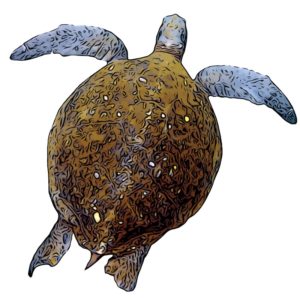
Hawksbill Sea Turtle
(Male)
Where to Look
- Santa Cruz Highlands
- Lagoons on Larger Islands
Similar Galapagos Species

Green Sea Turtle
(Anas bahamensis)

Identification
Both males and females are easily seperated from the larger, more common, White-cheecked Pintail by their plain black bills (no red spot at the base like the pintail), yellowish (not black) legs and feet and, in flight, their extensive pale blue wings.
Description
Males have buffy-brown underparts, relitively finely spotted with dark markings, dark brown backs, a black tail base and tail bordered by a white blotch on its lower flank, yellowish legs and feet, dark bills and grey heads with a dark crown and prominent white patch at the base of their bills. Females are overall brown with yellowish legs and feet, a dark horn colored bill, dark brown backs and dark brown scallops on their light brown underparts. Both sexes have extensive light blue patches on the leading edge of their wings visible in flight.
Galapagos Distribution
In the Galapagos, this species usually turns up in the highlands of Santa Cruz or lagoon systems of larger Islands such as Isabella, San Cristobal and Santa Cruz.
Global Distribution
It is a boreal migrant which breeds over large parts of the USA and Canada and overwinters throughout Mexico, the Carribean, Central America and the Northern parts of South America. In North America it is often the most common duck in many parts of its range.
Status in the Galapagos
Uncommon migrant recorded in small numbers throughout the year but most common between October and March.
